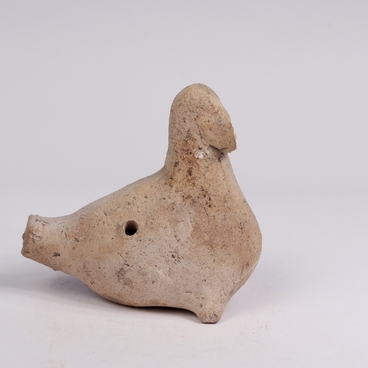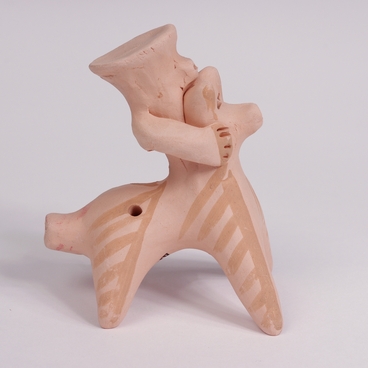This male figure was found during excavations in Stary Oskol. It is interesting that female figures made of baked clay appeared in the Paleolithic period, the first historical period of the Stone Age, about 2.6 million to 10–12 thousand years ago. Clay figurines depicting men appeared much later.
Although male figurines were found during excavations of the Greek colonial cities in the Northern Black Sea region, with which the Slavs actively traded, they appeared in Rus’ only in Christian times, approximately in the 15th century. At first, potters depicted them on horseback, and then separately, on their own. The earliest figure that has so far been found on the territory of Stary Oskol dates back to the 16th century. In the old days, such figures were called “general” or “horseman”.
The “General on a horse” from the museum collection was created presumably in the 18th century. Unfortunately, some parts of the toy have not survived because they were so old: the horse’s legs broke off, as well as the mouthpiece, which was used to extract the sound. However, the find is still very valuable: the horse’s head and the main part of its body remained intact. Thus, you can see that the artisans of that time left the shape of the toys rather simplified: the lower part of the horseman’s body merges with the horse’s body.
In the 16th — 18th centuries, the masters who made whistle-toys did not pay attention to men’s clothing: it was not depicted on purpose, it was simply implied. Moreover, the artists did not add any decorations to the figures. Even headdresses were made from a single piece of clay: a cap or a cocked hat. Most ancient figures have a headdress, although nothing is known for certain about the headdress of this particular toy.
On some of the horse figures, a simple ocher coloring has been preserved. Potters made ocher themselves. They placed mineral substances found in rocks, limonite or marcasite, in hot ovens. After firing, these substances acquired a denser red color. Artists usually did not paint the whole surface in one color — they drew arious straight and oblique lines, and sometimes they drew twigs.
Although male figurines were found during excavations of the Greek colonial cities in the Northern Black Sea region, with which the Slavs actively traded, they appeared in Rus’ only in Christian times, approximately in the 15th century. At first, potters depicted them on horseback, and then separately, on their own. The earliest figure that has so far been found on the territory of Stary Oskol dates back to the 16th century. In the old days, such figures were called “general” or “horseman”.
The “General on a horse” from the museum collection was created presumably in the 18th century. Unfortunately, some parts of the toy have not survived because they were so old: the horse’s legs broke off, as well as the mouthpiece, which was used to extract the sound. However, the find is still very valuable: the horse’s head and the main part of its body remained intact. Thus, you can see that the artisans of that time left the shape of the toys rather simplified: the lower part of the horseman’s body merges with the horse’s body.
In the 16th — 18th centuries, the masters who made whistle-toys did not pay attention to men’s clothing: it was not depicted on purpose, it was simply implied. Moreover, the artists did not add any decorations to the figures. Even headdresses were made from a single piece of clay: a cap or a cocked hat. Most ancient figures have a headdress, although nothing is known for certain about the headdress of this particular toy.
On some of the horse figures, a simple ocher coloring has been preserved. Potters made ocher themselves. They placed mineral substances found in rocks, limonite or marcasite, in hot ovens. After firing, these substances acquired a denser red color. Artists usually did not paint the whole surface in one color — they drew arious straight and oblique lines, and sometimes they drew twigs.

